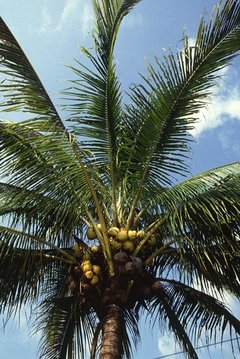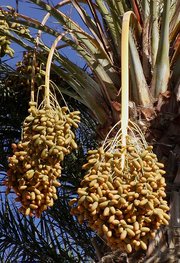Palm
Arecaceae (also known as Palmae), the Palm Family, is a family of flowering plants, belonging to the monocot order, Arecales. There are 202 currently known genera with around 2,600 species, most of which are restricted to tropical or subtropical climates. more...
Of all the families of plants, the Arecaceae is the most easily recognizable as distinct by most persons. The type member of this family is the areca palm, the fruit of which is chewed with the betel leaf and often confused with it. The Date Palm, Rattans, and Coconut also belong to this family. Palm oil is an edible vegetable oil produced by the oil palms in the genus Elaeis. Several species are harvested for heart of palm. Palm sap is sometimes fermented to produce palm wine. The Palm Sunday festival uses palms, hence the name.
Palms first appear in the fossil record around 70-80 million years ago, during the Cretaceous Period, making them one of the older families of flowering plants.
Economically important genera include:
- Areca
- Arenga
- Attalea
- Bactris
- Borassus - Palmyra Palm
- Calamus - Rattan palm
- Cocos - Coconut
- Copernicia - Carnauba wax palm
- Elaeis - Oil palm
- Euterpe Cabbage Heart Palm, and Açaí Palm
- Jessenia
- Jubaea - Chilean Wine Palm and Coquito Palm
- Orbignya
- Phoenix - Date palms
- Raphia - Raffia palm
- Rhapis
- Roystonea - Royal palm
- Sabal - Palmettos
- Salacca - Salak
- Trachycarpus
- Veitchia
- Wallichia
- Washingtonia
See list of Arecaceae genera for a complete listing.
Few palms tolerate severe cold, and the majority of the species are tropical or subtropical. The most cold-tolerant are Trachycarpus, native to eastern Asia, and Rhapidophyllum, native to the southeastern United States. For more details, see hardy palms.
In the United States, different types of palm trees can be seen in tropical and mediterranean climate areas, such as Florida, (southern) California and Hawaii and along the Gulf Coast through southern Georgia, Mississippi, Alabama, and Louisiana to Texas. The southeastern state of South Carolina is nicknamed the Palmetto State because of the number of palms that line the state's Atlantic coast. Some palms can be grown as far north as Maryland, Arkansas, and even up along the Pacific coast to Oregon and Washington. There have even been known species of transplanted palms that have survived as far north as southern New Jersey . The desert areas of Nevada, Arizona, Utah and New Mexico are also home to some native palms.
Southern Europe has two native palms, Chamaerops humilis (widespread, but mainly seen in Portugal, Spain, France, Italy and Malta) and Phoenix theophrastii (Crete; also southern Turkey). Many other palms are widely planted, with the Japanese Trachycarpus wagnerianus being grown successfully as far north as Iceland.
Read more at Wikipedia.org




